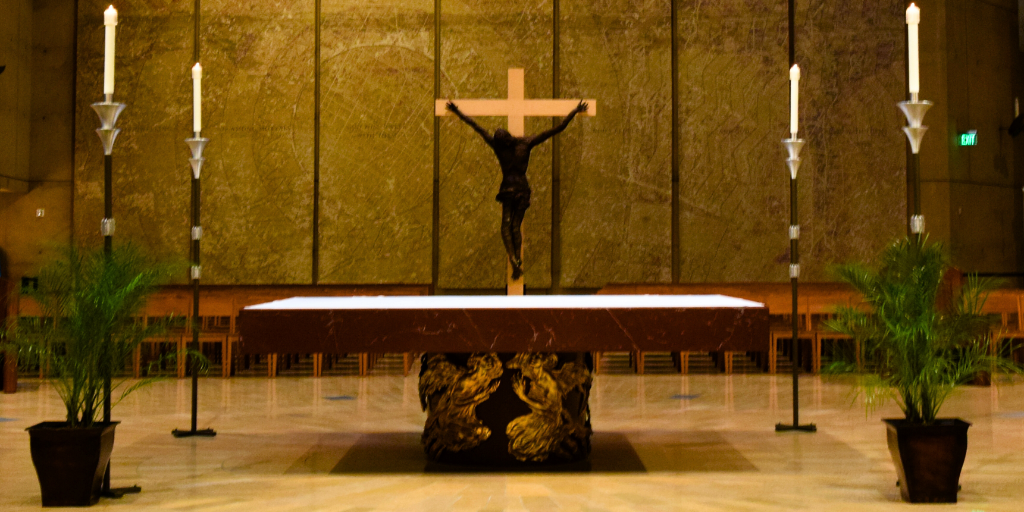
Kate Taliaferro reflects on a recent experience in her Catechesis of the Good Shepherd atrium and how the connections made there can last a lifetime.
“Look! It’s just like the altar!”
“Can you make silence with me?”
“Green is for growing, white is for celebrating, purple is for preparation, red is for Pentecost and the Holy Spirit.”
“I wonder…..”
These are just a few of the things heard regularly in my current atrium in our parish on any given Sunday. The atrium, or classroom, is the center of the catechetical model Catechesis of the Good Shepherd.
Catechesis of the Good Shepherd (CGS) is a catechetical model founded by Sophia Cavaletti and Gianna Gobbi in Rome in the 1950s. CGS aims to accompany children as they discover and grow in their relationship with God. Everything points to God, the loving Father, Jesus who is our Good Shepherd, and the Holy Spirit who is with us always. It is a gentle model of love and prayer following Montessori teaching methods and solid, age-appropriate catechesis.

Watching Children's Faith Being Formed Through Catechesis of the Good Shepherd
What follows is just one example from my current atrium that I especially wanted to share, because it touched me so deeply and I continue to reflect upon it.
For Holy Week, the children (in my atrium we have three 6-year-olds) were shown a presentation on the Last Supper. One of the many wonderful things about CGS is that there is a tactile component to everything. So there are 12 peg dolls, a table, a miniature tablecloth, a bowl with small pieces of bread, a chalice with red glue inside to mirror wine — everything. The teacher slowly read the story. As she read, she moved the pieces around the scene. When Jesus shared the bread with His disciples, she picked up the bowl and each one of the twelve is offered a taste. The same with the chalice. This slows down the story and focuses so closely on the action of the moment. When the story concludes, the disciples are walked away from the table as they go to the Garden of Gethsemane.
As we all know, the story doesn’t really end there. So the teacher reached into her basket and explained how, in the garden, Jesus was arrested and then crucified. She placed a small crucifix on the little table between the bread and wine. She then placed two of the smallest candles I’ve ever seen on the table, one on each end. These are real candles mind you, and she lit them. As she did, she reminded the children how Jesus doesn’t stay dead, but rises. As she lit the candles, one of the children’s eyes lit up, and he exclaimed, “Look! It’s just like the altar!”
Yes! I wanted to shout, Yes! Jesus celebrated the Passover, we celebrate what Jesus did! The bread, the wine, Jesus’ Body and Blood, here it is, you see what so many adults miss every week!
Big Theological Topics Presented in Age-Appropriate Ways
This is the beauty of CGS, right here. Children are presented with big, deep, theological topics, but they are shown them in such a way that they are accessible, tangible, and within reach. Not only are they shown these presentations, but they are encouraged to interact with them. Every week, the children are given the opportunity to work with any presentation they have already been shown. Everything is on their level and within reach. That same day during which they received the Last Supper presentation, I helped at least three children go back and retell the story, this time with them moving the disciples, setting the table, sharing the bread and wine.

I wish I could express more fully how impactful it is to watch a 4-year-old reverently set that table for the disciples to come to their Passover meal and to look on in wonder as the candles are lit. Wonder, beauty, patience, reverence: these are just scratching the surface of all the atrium can give to both the adults and children in the room. My faith is fed just as much as theirs from my time in the atrium.
Share your thoughts with the Catholic Mom community! You'll find the comment box below the author's bio and list of recommended articles.
Copyright 2024 Kate Taliaferro
Images: Canva
About the Author

Kate Taliaferro
Kate Taliaferro is an Air Force wife and mom of 6. She has a Masters in Religious Education and tries to find God's presence in all parts of her day, be it cooking, cleaning or just the everyday ordinary. She enjoys homeschooling, stitching crafts and finding cheerios between the couch cushions. She blogs at Daily Graces.


.png?width=1806&height=731&name=CatholicMom_hcfm_logo1_pos_871c_2728c%20(002).png)
Comments